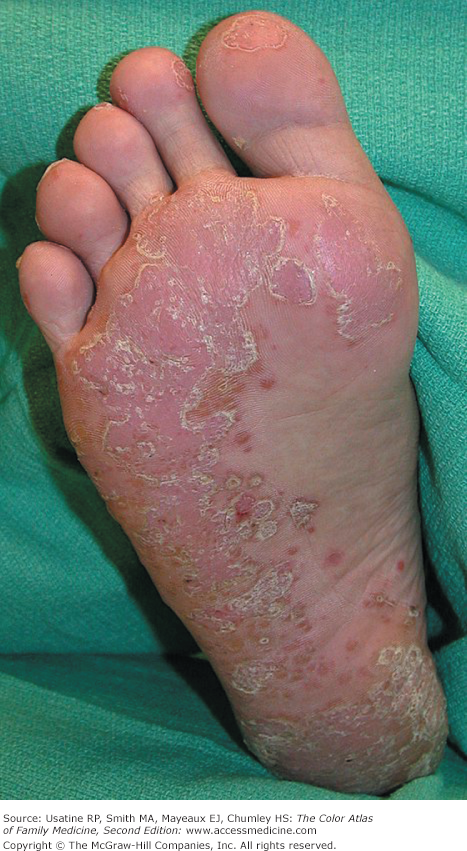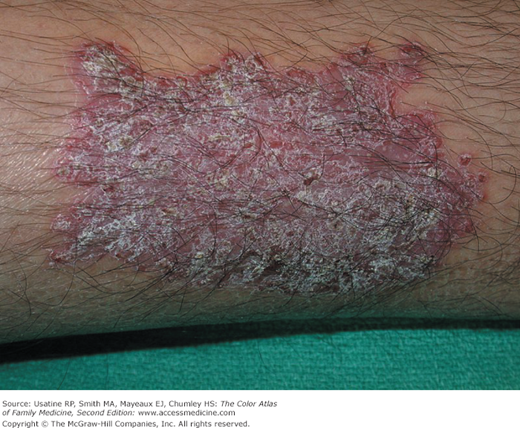Patient Story
A 29-year-old man presented with concerns about an extensive rash that had developed over the previous month. The rash was reported to involve the scalp, abdomen, penis, hands, and feet (Figures 155-1, 155-2, 155-3, 155-4, and 155-5). He also complained of severe joint pain, involving the back, knees, and feet. He denied ocular, GI, or genitourinary complaints, but was prescribed a course of antibiotics last month when his partner was diagnosed with Chlamydia.
Figure 155-2
Keratoderma blennorrhagicum with hyperkeratotic papules, plaques, and pustules that have coalesced to form circular borders. (From Shedd AD, Reddy SG, Meffert JJ, Kraus EW. Acute onset of rash and oligoarthritis. J Fam Pract. 2007;56(10):811-814. Reproduced with permission from Frontline Medical Communications.)
Figure 155-3
Erythema and scale seen on the toes of the patient in Figure 155-1. Note the nail involvement with subungual keratosis and onycholysis. The fourth toe is red and swollen; this is called dactylitis. (From Shedd AD, Reddy SG, Meffert JJ, Kraus EW. Acute onset of rash and oligoarthritis. J Fam Pract. 2007;56(10):811-814. Reproduced with permission from Frontline Medical Communications.)
Figure 155-4
The patient in Figure 155-1 with psoriasiform lesion on the corona and glans. The patient also has erythema in the inguinal area that resembles inverse psoriasis. This particular case does not exemplify classic balanitis circinata, which is characterized by annular or arcuate thin scaly plaques, as opposed to the nonspecific scaly plaques found on this patient. (Courtesy of Suraj Reddy, MD.)
Figure 155-5
Psoriatic-appearing plaque on the leg in the same patient with reactive arthritis in Figure 155-1. (From Shedd AD, Reddy SG, Meffert JJ, Kraus EW. Acute onset of rash and oligoarthritis. J Fam Pract. 2007;56(10):811-814. Reproduced with permission from Frontline Medical Communications.)
The patient’s young age, rapid onset of symptoms, dermatologic findings, and arthritis were suggestive of reactive arthritis. The patient’s joint pain was treated with NSAIDs and skin lesions were treated with topical corticosteroids. No antibiotics were prescribed because no current infectious agent was identified. In conjunction with a dermatologist, acitretin 25 mg daily was started to treat his psoriasiform lesions.
Introduction
Reactive arthritis is a noninfectious acute oligoarthritis that occurs in response to an infection, most commonly in the GI or urogenital tract. Patients present 1 to 4 weeks after the triggering infection, with joint pain in asymmetric large joints; eye disease, such as conjunctivitis; and skin changes including erythema nodosum, keratoderma blennorrhagicum, and circinate balanitis. Diagnosis is based on the clinical presentation plus evidence of associated infection. Treatment includes antiinflammatory medications and treatment of triggering infection.
Synonyms
Epidemiology
Etiology and Pathophysiology
- Follows a GI (Yersinia, Salmonella, Shigella

Stay updated, free articles. Join our Telegram channel

Full access? Get Clinical Tree







